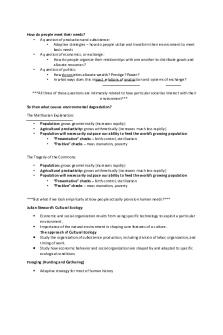Modes of documentary representation PDF

| Title | Modes of documentary representation |
|---|---|
| Author | David Maclean |
| Course | Film, Culture and Communication |
| Institution | Queen's University |
| Pages | 2 |
| File Size | 68 KB |
| File Type | |
| Total Downloads | 97 |
| Total Views | 147 |
Summary
Download Modes of documentary representation PDF
Description
Modes of documentary representation: Poetic: Instead of using traditional linear continuity to create story structure, the poetic documentary filmmaker arrives at its point by arranging footage in an order to evoke an audience association through tone, rhythm, or spatial juxtaposition. Expository: Also having first appeared in the 1920's along with the poetic documentary, the expository documentary on the other hand constructs a specific argument or a point of view for the audience. Generally, the formula is a resonating, authoritative voice (like the silky baritone of Morgan Freeman in March of the Penguins) that tells you something with corresponding footage proving that it is, indeed, true. Or Nanook of the North’s titles. Observational Cinema: In reaction to previous forms of documentary and to changing camera technology, both Direct Cinema and Cinema Verite movements started to appear in the 1960s that embraced observational documentary -- that is, the filmmaker observing truth by letting the camera capture its subjects uninterrupted. Cinèma Vérité (Film Truth) Direct Cinema Cinema Vecu (Lived Film) All these terms mean more or less the same thing. But Cinèma Vérité has been associated with the more politically or socially engaged documentary practices. Direct Cinema was in many respects a reaction to, and a rebellion from, the “voice of God” narrated documentary that was common in the 1940s and ‘50s around the world. Also, during the 1950s and 60s there was a strong movement away from the artifice of much fiction filmmaking toward a passion for realism on many levels: both formally and in terms of content. It became a search for “truth.” Almost a scientific kind of truth. What we might call empirical knowledge of the world. That was coupled with an increased interest in aspects of everyday life. It was also a time of profound social change, as we touched on last week. New realities required new artistic forms. It was a time of formal experimentation in an attempt to grapple with and express these changes. Finally there were really important developments in the technology of filmmaking that suddenly made a different kind of cinema possible. - Film stocks that were finer grain and more sensitive to light made shooting inside without special lights possible. - 16mm film stock and light weight cameras made fluid, hand-held camerawork feasible and brought down the costs of shooting large quantities of material.
- A small portable professional tape recorder called a Nagra made the recording of synchronous sound in any location a reality. Main Features of Direct Cinema: - no voice over narration - capturing events as they occur - unscripted - available light, handheld photography - natural story lines based on a “crisis structure” - the camera as a catalyst - editing that follows the rhythms of everyday life - open to a variety of readings Participatory Documentary Around the same time as Direct Cinema style of observing without interfering showed up, so did the opposite sensibility. The participatory documentary invited the subjects to participate with the filmmaker -- usually by being interviewed. The first-person storytelling accounts shared with Errol Morris in his breakout film The Thin Blue Line should be in every filmmaker's must-watch queue. https://youtu.be/SXBFt0b7nB0 Reflexive Documentary The most Brechtian of the sub-genres, reflexive documentary is not about the relationship with the filmmaker and the subject, but rather the filmmaker and the audience. Showing the man (or woman) behind the curtain to the audience should shake the core of the whole damned process of storytelling, as in Sarah Polley's masterful Stories We Tell....
Similar Free PDFs

Modes of Acquiring Nationality
- 1 Pages

Emerging modes of business
- 3 Pages

Modes of Subsistence
- 4 Pages

Modes of extinguishment
- 19 Pages

Types of Addressing Modes
- 6 Pages

Letter of Representation
- 2 Pages

Geography OF Representation
- 6 Pages

4. Modes of Originating Summons
- 4 Pages

Representation
- 2 Pages

Grants of Representation
- 2 Pages
Popular Institutions
- Tinajero National High School - Annex
- Politeknik Caltex Riau
- Yokohama City University
- SGT University
- University of Al-Qadisiyah
- Divine Word College of Vigan
- Techniek College Rotterdam
- Universidade de Santiago
- Universiti Teknologi MARA Cawangan Johor Kampus Pasir Gudang
- Poltekkes Kemenkes Yogyakarta
- Baguio City National High School
- Colegio san marcos
- preparatoria uno
- Centro de Bachillerato Tecnológico Industrial y de Servicios No. 107
- Dalian Maritime University
- Quang Trung Secondary School
- Colegio Tecnológico en Informática
- Corporación Regional de Educación Superior
- Grupo CEDVA
- Dar Al Uloom University
- Centro de Estudios Preuniversitarios de la Universidad Nacional de Ingeniería
- 上智大学
- Aakash International School, Nuna Majara
- San Felipe Neri Catholic School
- Kang Chiao International School - New Taipei City
- Misamis Occidental National High School
- Institución Educativa Escuela Normal Juan Ladrilleros
- Kolehiyo ng Pantukan
- Batanes State College
- Instituto Continental
- Sekolah Menengah Kejuruan Kesehatan Kaltara (Tarakan)
- Colegio de La Inmaculada Concepcion - Cebu





